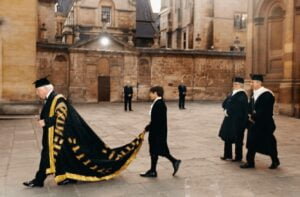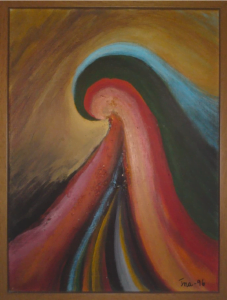This piece is a Creative Nonfiction (CNF), part biography of my grandma, womanhood and fire, and part mythology. Religion walking next to identity has this poetic element to it often presenting fear as faith. The piece is a reflection on stories told in childhood, stories that I disengage yet visit in memory. In the end fantasizing childhood, world, and ways of being.

A choolah is a small earthen stove, the same choolah becomes ‘sanjha choolah‘ in a community kitchen where people share songs, stories and food around fire.
My Grandmother, Tara, Star or the light of the soul
Tara’s heart relied on a piece of land her husband and her children called ‘home’.
After her wedding, at the crisp young age of fourteen
she left what she called home to live,
in her in-laws eight room house,
with seven brothers and two sisters in laws,
building and re-building the choolah in turns.
Over the years with names and numbers added to her family the choolah has evolved in size and shape.
Twenty-six years ago, after marrying Tara’s son, my mother left her home to live in Tara’s house, and eventually the choolah got replaced by a gas stove.
The fire that sat at the centre of the house was only ignited on special occasions.
After my brother’s birth, walls were repainted, a window was added, ceramic tiles were laid, on which a six-seater dining table was placed, then a flat tabletop erected so the gas stove could sit.
And the choolah was carried, crippled, it’s several pieces left in a nook.
Aloof, scattered, shapeless and unattended.
My Tara or the light of my soul, the builder of the choolah is no more and her offspring or the keepers of the choolah are scattered in towns and countries afar.
Tara mastered the art of igniting and tending the fire, my mother only knows how to light a fire, I am only aware of the stories and songs that were shared around that fire and I am afraid, if ever I have children, they will only selfishly see fire from a distance.
Nivaas or dwelling
The women leave their dwellings to look for the moistest of soil at dawn. Children, mothers and grandmothers gather by day to pick twigs and pebbles out of that soil, their hands then knead the mud to give it the smoothest of textures and a good hold. Then the eldest woman of the family starts to build two sides facing each other adjoining the wall, then four corners, a peep hole on the top, and a mouth. Once ready, it’s left alone to dry overnight, so in the morning as the first cup of chai is served, each member of the family can make their offerings.
Drops of chai are sprinkled before the first sip
with a piece of jaggery
in the name of Agni, the god of fire.
The fire that sits at the centre of a house. A house that becomes home. A home with elders, parents and children clustered around a choolah. A choolah that feeds the empty stomach of men who sow rice in kharif or autumn or the beginning of the first rains
and sow pulses in rabi or spring or the withdrawal of monsoon
and the women who walk the fields
to pray
as the seeds are sown,
the roots that grow,
the sun that turns the grain into gold
and Indra, the god of rain that seeps into the spirit of the soil.
In this way the men are wedded to the tilling of soil and women to praying and the creation of fire, rain and a dwelling.
Grihastha or Household
It’s the first night of my oldest cousin’s marriage ceremony. She and her lover will walk seven times around fire forecasting a union of seven lifetimes.
As the pujari or priest acknowledges Agni that sits at the centre of the parikrama.
People walk forwards, one by one and sit around it to listen earnestly to the story of faith.
Faith that lives in books of wisdom or vedas, ruptured a little, here and there by time.
vedas that live tall, gloriously, like pillars of life, holding together every grihastha or household.
“My companion, lover and my most trusted friend with this first step I pray to be blessed with nourishment, a fertile soil, lush green fields, trees with flavourful fruits and an abundant flower bed.
By the second step I pray
for physical strength and safety
a mind that is focused, still water,
and a spirit that is always seeking and always learning.
By the third step I pray for success. May we be brave to barter, may we know our worth.
By the fourth step I pray for fame, may our names be known to all, may they know us and the roads that lead to us. May we be nurtured by the community; may we nurture them.
By the fifth we pray for fertility, may we always create, may we also learn to look after what we create from time to time. May we be full of passion. May we never stop creating.
By the sixth step we pray for the wind to favour us and for the sun to melt the snow, may we see rainfall and a soil that is always fertile.
By the seventh we pray to flourish together, reincarnating, shedding our old bodies whilst wearing new ones. May we come to know the goodness in each other and learn through what we lack. May we learn to make peace next to each other in this life and all the other seven lifetimes.
Prayers have managed to live, recited endlessly, practiced to perfection.
Prayers that become the book of life for the fainthearted.
Prayers that guide those who walk aimlessly.
Prayers that renew.
Prayers that are remembered forever.
After my brother’s birth, our house was refurbished, then invitations sent out for a griha pravesh, my mother sat next to the purohit to make a list of havan samagri . Dry herbs, flowers with pleasant smells, roots of ancient trees were collected from the selected suppliers. Then kids rushed to the marigold flower beds, picking each gently. The daughters tied threads to their needles making garlands. The wisest and the most experienced, the elders, bathed and cleaned, to open the kitchen doors and prepare a feast. The women from the neighbourhood poured in to assist. Rugs and carpets were dragged out from all the old trunks. Then dusted, washed and spread around the Havan kund .
Once ready, a fire was lit which burned with the purohit’s synchronic ‘swaha’ chant.
Swaha and Agni
Every mantra is concluded by saying “swaha!”
Swaha is a feminine noun in Rig Veda, one of the four sacred texts in Hinduism.
Swaha is also chanted during a yagna, a Hindu ritual performed in front of Agni.
Swaha is the name of a nymph.
Swaha is soul, Agni is energy.
Swaha is desire.
While we sit around fire warming, asking, praying, sharing and living, there are plenty of unheard stories of Agni eating away life. There is an unignorable pleasure to see it from a distance as it swerves branch to branch, in soft whispers, never properly announcing its arrival and departing to places undisclosed. I have heard of one such story from my grandmother’s lap in a sea of those who look for guidance in those books of wisdom.
Once in the northern sky, lived the seven sages with their seven wives. Agni on his usual walks in between land and sky, gets a glimpse of the beauty of those pristine wives and instantly falls in love with them. To attain the love of the wives, Agni resorts to destruction and eats away whatever it sees living and loving around it. Unable to end Agni’s rage, seven of them sat together praying to Indra and soon rain followed soothing Agni’s rage.
Agni defeated, walks a few forests then chooses the densest trees to settle next to. Across the trees lived a nymph, a learned maiden, always traversing one world to another with an instant ease. So nameless and formless she roamed, remembered by sages, recalled in prayers, omnipresent.
The nymph day in day out hides in the trees watching his dance of rage and grief, one-minute wild, the other collected. A display of a deep-seated rage, a dance of power. Unstoppable power.
Nights and days later, a wind comes, a few leaves flutter a little here and there, and then out of the trees appears the nymph, in the form of the first wife of the seven sages. Agni, enchanted by this vision, expresses to her that his heart has eagerly waited for her and now that she has submitted to him, he can rightfully make love to her.
The next morning Agni wakes up and she has already left his bed. A longing of lifetimes, a love of one night. Troubled and confused he moves nook to nook calling her name looking for her.
By evening with another wind, the nymph appears again, this time in the form of the second wife and promises to stay for a night. Agni crippled by his urges, accepts the offer. And so, for the other few nights all wives visited one by one until the seventh night where a wind came and then another, leaves fluttered, and again the nymph appeared, this time, anxious, beaten, and formless.
Agni, perplexed, tells her that he has been waiting for Arundhati, the wife of the seventh sage. The nymph, caught in her act, confesses her desire to Agni . Her longing for some name, form, and shape.
“I have come to you in different forms and have made love to you each day with the same passion. But my beloved, it is the love of Arundhati that is the purest of them all. I have taken different forms and disguised the world but this time only to display love in the purest seven forms. And today on the final day, I have failed to be Arundhati, as her love is the truest of all, a love all aspire to have, a love worth imitating but a love unattainable.”
And Agni, impressed by the nymph’s display of desire, named her ‘Swaha’.
In this way Swaha, which is a feminine entity, or a female longing became Agni’s consort.
Forever remembered, recalled, and acknowledged with Agni. Their love spawns from desire, desperation, and rage but their love is also an imitation of the purest love. Agni when assigned a place to sit with the chanting of Swaha leads to the creation of a choolah, a nivaas or dwelling, a grihastha or household and a love of seven lifetimes.
Madhvi Thakur

Madhvi is a bi-lingual writer, scholar, and sometimes ghost-writer. Gender, sexuality, and culture are three themes that inspire most of her work.




